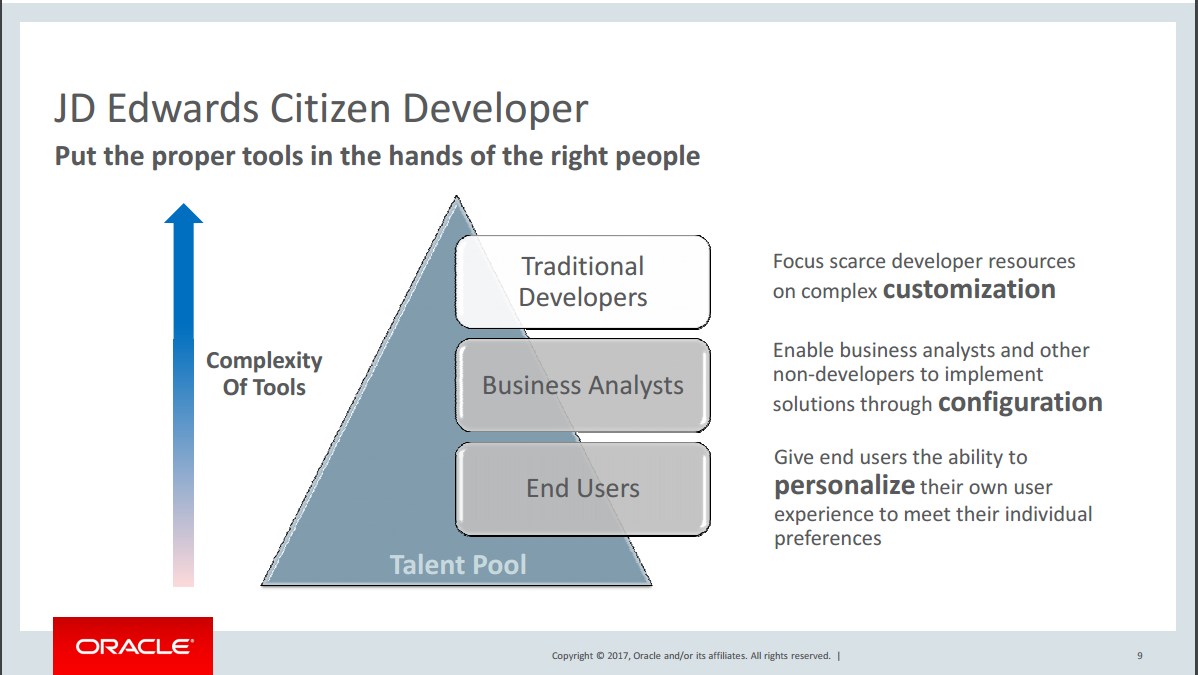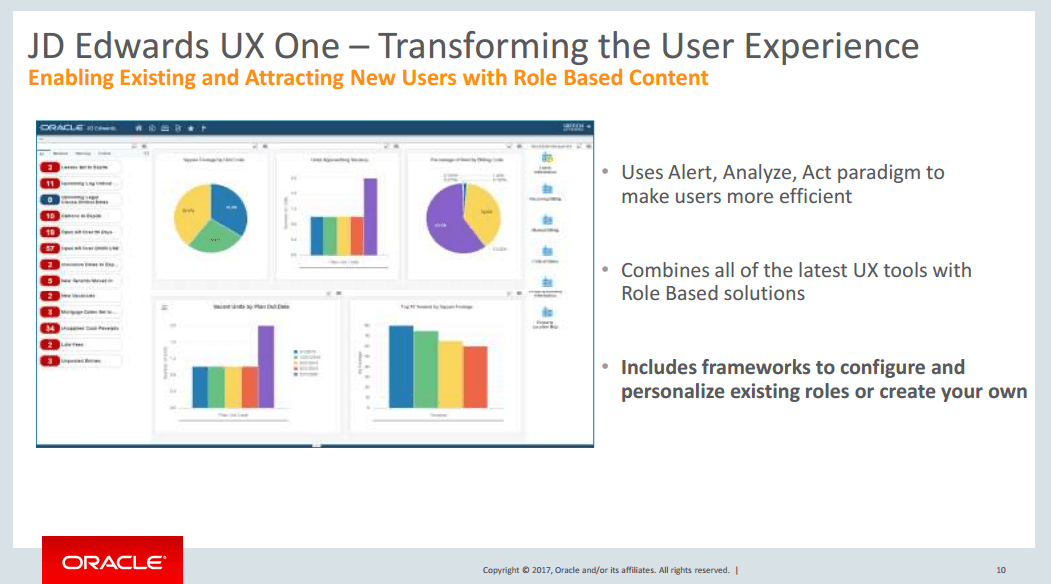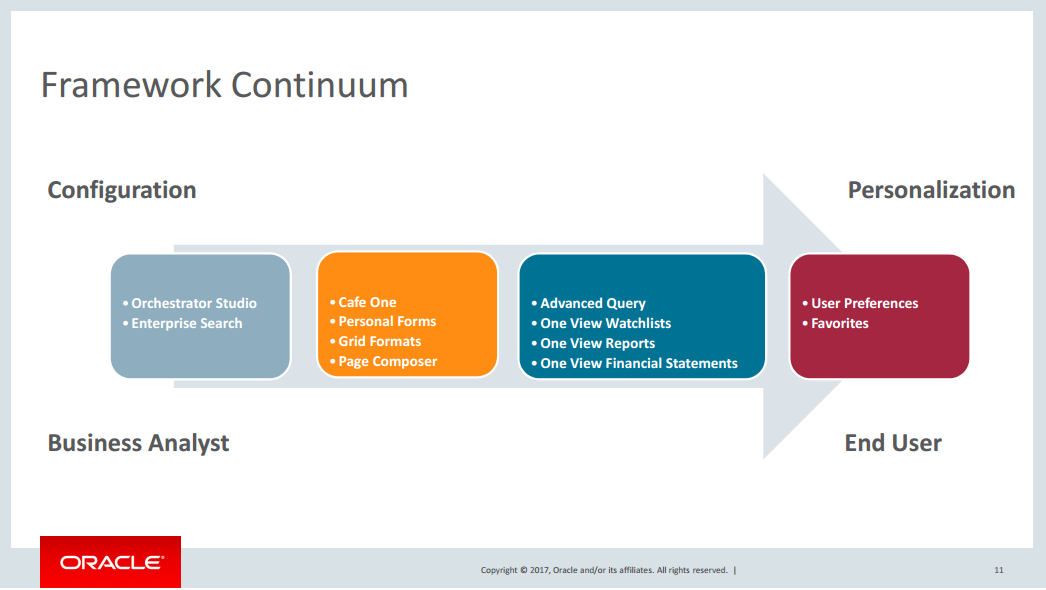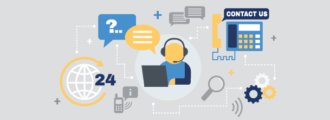We recently had the opportunity to chat with Bob Monahan, Vice President of Product Management for JD Edwards at Oracle. Bob was gracious enough to spend a few minutes discussing the concept of the citizen developer, UX One, and why customers may want to upgrade to EnterpriseOne 9.2. Below is a lightly edited version of that conversation.
Aaron Chappell: Bob, first off thanks so much for your time. Can you tell me a little bit about yourself and how you got into the JD Edwards ecosystem?
Bob Monahan: Sure. I’ve been working on the JD Edwards product now for over 30 years. My first job was with Chevron. I worked for them for back in the 1980s in Denver until the drop in oil production resulted in many oil companies relocating from the Rocky Mountain region to Texas and Louisiana. I decided to stay in Colorado. There was a new company starting to grow named JD Edwards. I took a chance and changed careers, industries, and I’ve been with the JD Edwards product ever since.
Aaron Chappell: To those who might not know, how would you best describe your role within the Oracle organization?
Bob Monahan: I’m Vice President for our Product Management team. That’s the team that works a lot with our customers, defining and building requirements, and then working with our Development, QA, and Content teams to build and deliver our products to the marketplace.
Aaron Chappell: I wanted to talk to you today about the concept of the citizen developer. How would you best describe a citizen developer and the benefit that this idea brings to the IT community?
Bob Monahan: The concept of citizen developer is really about allowing business analysts or end users to configure or personalize the system to meet the way they need to do their business. In the past, if you needed an application UI to have a different layout or you needed a specific report, you had to go to IT and ask for a modification. Waiting for those development skills to be available to work on your requests could take weeks, months, or maybe it never happened. And those resulting modifications could add more overhead cost to future patching retrofits or make it more difficult to stay current with new enhancements.
So we’ve got to get away from having users rely on their IT development staff to make these types of application modifications and be able to put the power in the hands of business analysts and end users to configure and personalize the system the way they need.
Aaron Chappell: Can citizen developer options work alongside a standard EnterpriseOne development structure? How do they integrate together and play together?
Bob Monahan: Actually it’s all just part of the JD Edwards EnterpriseOne product. We’ve had the concept of configurations in JD Edwards since the 1980s. Starting with Release 9.1 and now with Release 9.2, we have added significant new Configuration and Personalization capability. Some examples include:
- Composite Application Framework (CafeOne)
- Personalized Advanced Query Searches
- Personalized Grid formats
- Ability to create your own personal reports and formats (One View Reporting)
- Orchestration Studio
- New Role-Based Landing pages
- Personal Application Header form design
- Enterprise Search.
We refer to all of these business analyst or end user personalizations as User Defined Objects. These are maintained with a common lifecycle management process throughout the JD Edwards EnterpriseOne product. This greatly simplifies the learning, adoption, and administrative management of these personal objects.
Aaron Chappell: What advice would you give to a company that might feel maybe a little uncomfortable giving end users that degree of freedom and control?
Bob Monahan: Usually, I see companies putting those types of decisions into the hands of a business analyst or a power user in a certain department. And they define what is going to be the group’s standard. Usually, it’s a group of people that then define those configurations, and decide on personalizations they want to enable and then roll out to all of the users. That way it doesn’t become the Wild Wild West where you just let everybody do whatever they want. My best advice is to have some type of governance structure and consistency in place.
Aaron Chappell: Shifting gears over to the UX One functionality, how would you best describe UX One to those who might not be familiar with the term?
Bob Monahan: The first thing I would say is UX One is not a product. UX One is really a brand name, as opposed to something you license. Oracle is putting out many, many enhancements in the area of user interface. Instead of just talking about all these things individually, we decided to roll them up under the overall user experience brand name. So for EnterpriseOne, we called it UX One. It’s really a composite of many different functional enhancements that we’ve put in the product to enable and improve the overall user experience of JD Edwards.
Aaron Chappell: What would be the key advantages that are gained by companies using UX One and UX One enhancements?
Bob Monahan: The goal ultimately is to make the software more intuitive for the end users. Years ago, companies all focused on feature and function. Decision-makers sent RFIs that were hundreds of line items of things they wanted to do with the product. It was all feature function. Today, functionality is still very important, but equally important is usability. Companies can’t afford long training times for users to learn the software. It needs to be intuitive and quickly adopted by the user community. And users will not get the most out of the product if they can’t easily personalize and configure the software to meet their business and process needs. If you can’t use the software, it really doesn’t matter what it can do. It’s about providing value and balance between usability and functionality.
Nucleus Research, an analyst firm, created their ERP Value Matrix, which evaluates ERP products on both functionality and usability. JD Edwards EnterpriseOne is positioned in the leader’s quadrant on this evaluation.
That’s the power of where we’re focused. UX One drives that usability. So regardless of whether people are working in their offices, or remotely, or whether they’re an executive at the company or one of the outside technicians, UX One allows customers to really extend the value of the JD Edwards ERP system to all reaches of the company.
Related:Forecasting a More Efficient Future
Aaron Chappell: You mentioned UX One Landing pages being built using a paradigm of Alert, Analyze, and Act. Can you provide us with some more insight on how these new UX One Landing Pages provide value to your customers?
Bob Monahan: JD Edwards has delivered more than 50 Role-Based Landing Pages or Home Pages. The goal is that this will be the primary starting application for users. Each Landing Page is designed to have information that is focused and relevant for a specific role such as an AP Manager, Customer Service Manager, or a Maintenance Manager.
The information on each Landing Page is comprised of Watchlists, Analytics, and applications commonly used by each role. Watchlists provide the user with visual alerts to exceptions within their business processes, the Analytics provide greater visual insight to business metrics for this role and the related applications allow the user to easily act on the presented information. The Watchlists, Analytics, and related Applications can all be configured and personalized by the citizen developers to meet the unique needs of each business. The Landing Pages deliver value of an intuitive interface that provides the users the information they need to know for their role and the ability to quickly act on that information.
Aaron Chappell: So if I’m a net new 9.2 installation, does all of that functionality come prepackaged?
Bob Monahan: It does. It comes prepackaged and then you configure and personalize it to fit your unique business.
Aaron Chappell: For customers running 9.0 or even 9.1, that’s a great reason to upgrade to 9.2, right?
Bob Monahan: That’s an excellent reason. We started to deliver some of the UX One foundation to allow the personalization and configuration capability with our Tools 9.1 release. For example, customers with 9.1 have the ability of building pages, but they have to do it themselves. The advantage with 9.2 is that now we’re now providing the Application prebuilt content on top of that foundation. With 9.2 we’re doing the assembly at the factory and delivering it so it makes it much easier for rapid adoption and for getting the value out of the product.
Aaron Chappell: We hear the term “post-modern ERP” thrown around quite a bit these days. And we’ve seen a culture shift away from the all-in-one solution towards more of an à la carte software approach. What role has this shift played in the formation of these specific products and the value they deliver?
Bob Monahan: The concept of a “post-modern ERP” as defined by Gartner is a strategy that moves away from a tightly integrated, inflexible ERP system towards a more agile, flexible, and loosely coupled set of integrated applications that support your intended business outcomes.
The JD Edwards common data model and common development tools that create a natively integrated single suite of product with a consistent end user Application experience and a low TCO is very valuable our customers. However, flexibility and agility are also very important to achieving the desired outcomes of the business. The configuration and personalization capabilities within the product provide our customers the control, flexibility, and agility they need to easily adapt the software to changing business conditions. The product integration capabilities including the relatively new Orchestrator integration tools provide customers with the tools needed to easily integrate other applications with the other products, including Cloud-based products, that may be needed by different lines of operational business. We are providing our customers both the choice and control they need to achieve their business outcomes.
Aaron Chappell: How do these Citizen Developer concepts of configuration and personalization play into future things that we might see with JD Edwards? How does that influence the approach your team is taking to develop new applications and functionality moving forward?
Bob Monahan: We are always considering how we can provide business analysts and end users with options on how they can configure and personalize future new enhancements to meet the needs of their business. For example, we are working on an enhancement to allow notifications to be proactively pushed to users. The idea is to allow users to define notifications based on a business outcome, the frequency of the notifications, and the method by which they are sent. Likewise, users need the ability to select which notifications they wish to subscribe to. Configuration and personalization options will be very important to allow each business to tailor these capabilities to their business operations.






